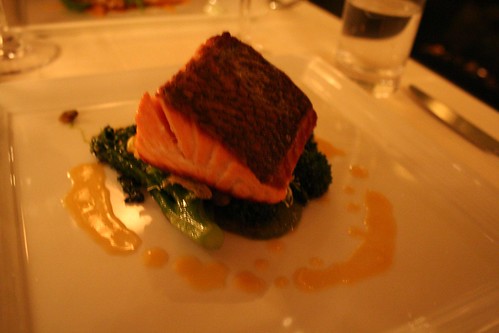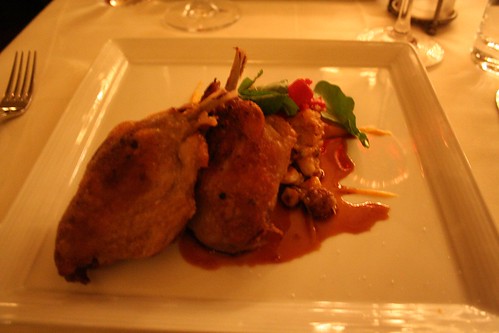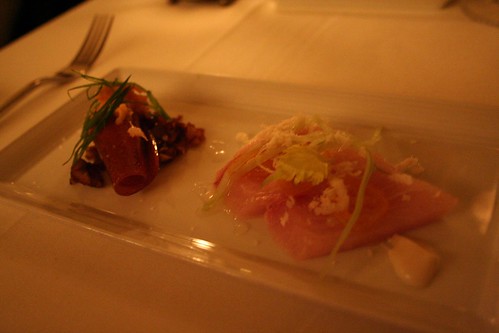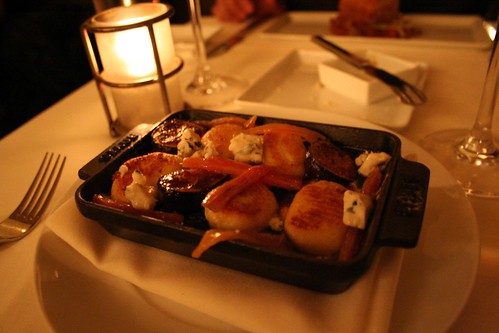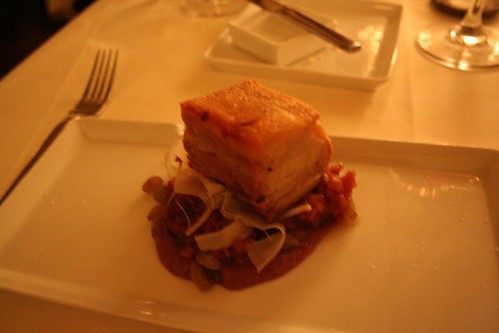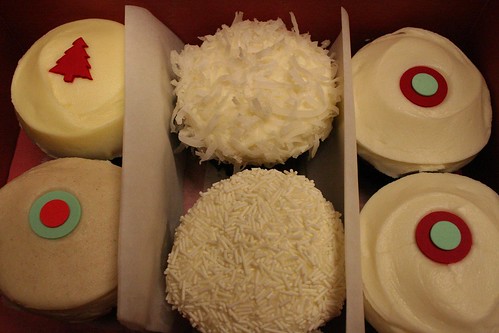Aloha! Let it be said that Camille and I aren't huge fans being in water. Which would probably present a problem for us when visiting Hawaii, except Hawaii has awesome food. Also, it's sunny and warm and lush and beautiful. But you knew that.
We went a year ago for a wedding and visited the Big Island and Oahu. It was a trip that laid the groundwork for this blog, but despite the endless pictures of food, I never got my thoughts down to clearly write about it. So, some real quick recommendations...
Big Island
Merriman's in Waimea. Chef/owner Peter Merriman is one of the twelve founding chefs of the Hawaiian Regional Cuisine movement, and this restaurant really lets the local ingredients shine. However, Merriman's Market Cafe in the Waikoloa resort/mall is very underwhelming. If you're interested in a great sandwich, head down to Island Lava Java in Kona and get yourself some coffee while you're at it. If you're in the market for some coffee beans, you'll have plenty of options. Mountain Thunder's very nice.
Oahu
The best plate lunch in Honolulu is Yama's Fish Market. It's not really near any tourist strips, which is a good thing. A wide variety of plate lunches (very good lau lau) to choose from, as well as a vast selection of poke. Matsumoto Shave Ice is an enormous tourist attraction in the North Shore town of Hale'iwa, and for good reason. They shave the ice down to a perfect, snow-like texture that you don't have to chew. I'd recommend adding ice cream and red bean, and hell, buy yourself a T-shirt. (By the way, any place on the island that offers "shaved ice" is a fraud.) On the way to Matsumoto's, you'll probably see the shrimp trucks parked along the road. Giovanni's Shrimp Truck loads on the butter and garlic for a great shrimp scampi. And if you bring a sharpie, you can scrawl your name on the graffiti-covered truck. If you're looking for fine dining and another one of those Hawaiian Regional Chefs, I highly recommend Alan Wong's in Honolulu. It's in a nondescript office building that you'll surely miss on first pass, but inside is terrific food terrifically served. I'm pretty sure we had a guy who's only job was to introduce the dish and suggest the ideal way of eating it. You'll pay for this type of thing in the end, sure, but it's always nice to have one fine dining night on a vacation.
 This year, we had another wedding to attend, this time in Maui. In the chain of islands, Maui sits between the Big Island and Oahu. In terms of energy and culture, I found Maui to be an interesting mix of Oahu's urban paradise vibe and Hawaii's lava-fields-with-beach-resorts thing. If I had to pick one word to describe Maui, it'd be rural. And if I had to pick a second word, it'd be immigrants. The locals who didn't work the tourist trade all seemed to work the lands. And in stark contrast to Oahu's markedly Asian demographic, a great many locals in Maui are, well... I believe the politically correct term is "whitey." Some of the Hawaiians who waited on us hailed from Huntington Beach, Irvine, and the Czech Republic. After returning from the lush road to Hana, we ate in the quaint town of Paia and were enveloped by European accents from all over. I have no hard data to back this up, but it sure seems like the people who decide to move to Hawaii end up choosing Maui. So it is that some of the best local food we had was prepared by a Seattle-raised sous chef and German goat cheese makers.
This year, we had another wedding to attend, this time in Maui. In the chain of islands, Maui sits between the Big Island and Oahu. In terms of energy and culture, I found Maui to be an interesting mix of Oahu's urban paradise vibe and Hawaii's lava-fields-with-beach-resorts thing. If I had to pick one word to describe Maui, it'd be rural. And if I had to pick a second word, it'd be immigrants. The locals who didn't work the tourist trade all seemed to work the lands. And in stark contrast to Oahu's markedly Asian demographic, a great many locals in Maui are, well... I believe the politically correct term is "whitey." Some of the Hawaiians who waited on us hailed from Huntington Beach, Irvine, and the Czech Republic. After returning from the lush road to Hana, we ate in the quaint town of Paia and were enveloped by European accents from all over. I have no hard data to back this up, but it sure seems like the people who decide to move to Hawaii end up choosing Maui. So it is that some of the best local food we had was prepared by a Seattle-raised sous chef and German goat cheese makers.
One of the most iconic things about Hawaii and Hawaiian food is, of course, the kalua pork at luaus. It's fast becoming one of my favorites, in part because of its simplicity: salt the pork, wrap, and roast for a long time. If you don't have the time, space, or inclination to dig yourself an imu, heat some stones, and bury a whole pig on top of it with some earth, then you can google yourself a recipe that will require liquid smoke and several hours in your oven.
 One of my favorite ways to have kalua is part of a mix plate. The plate lunch is another deeply Hawaiian dish, with Hawaii's immigrant history literally on display right in your styrofoam container. Kalua, teriyaki, fish, whatever you fancy, it's all there with scoops of rice and macaroni salad. As with any region's famous food, mix plates have become ubiquitous in Hawaii to the point that you may encounter a place with hurried, bland food. Such is the case with the oft-recommended Aloha Mixed Plate, a restaurant in Lahaina that inhabits every tourist flyer and dining guide at the airport.
One of my favorite ways to have kalua is part of a mix plate. The plate lunch is another deeply Hawaiian dish, with Hawaii's immigrant history literally on display right in your styrofoam container. Kalua, teriyaki, fish, whatever you fancy, it's all there with scoops of rice and macaroni salad. As with any region's famous food, mix plates have become ubiquitous in Hawaii to the point that you may encounter a place with hurried, bland food. Such is the case with the oft-recommended Aloha Mixed Plate, a restaurant in Lahaina that inhabits every tourist flyer and dining guide at the airport.
I wouldn't say it's bad. In fact, the appetizer of coconut prawns was a very promising beginning to our trip. The sweetness of the shrimp and the nuttiness of the dried coconut go really well together, and for a deep fried food, it wasn't terribly oily. Combine that with our table right at the edge of Aloha Mixed Plate's cozy, oceanfront patio, and it sure seemed as if Pele was smiling down on our arrival. And then the plates arrived.
The lomi lomi and macaroni salad were fine enough. I didn't like the poi, but I've never liked poi, so I don't hold that against anybody. At first, I couldn't figure out what bothered me about the kalua, but after several fork fulls in my mouth, I slowly realized what was missing: some flavor. Way under seasoned. No smokiness at all. Even a little on the dry side. I tried some of Camille's pork lau lau, but it was the same. The ti leaf wrap adds a nice layer, but it was still bland. She noted that there wasn't much fat, and certainly lean pork might explain some of this, but at the end of the day, it was severely lacking.
I wonder if Aloha Mix Plate was having a bad day, because their sister establishment right next door, Old Lahaina Luau, had pretty solid food. Considering Old Lahaina Luau serves 500+ people every night, you'd think they would have the bland food. Then again, they actually make their kalua in the traditional way.

 Again, Aloha Mix Plate ain't bad. But you won't regret skipping it, either. My vote for best plate lunch goes to local chain Da Kitchen. They really pile it on. Lots of choices, big servings, and pork the way I like it: salty and fatty and juicy. Yum. Plus, bonus points for wrapping their lau lau in an outer layer of leaf and knotting it up. You could probably attach it to your belt loop if you were so inclined. Not saying you'd be cool or anything, but it's physically possible, that's all.
Again, Aloha Mix Plate ain't bad. But you won't regret skipping it, either. My vote for best plate lunch goes to local chain Da Kitchen. They really pile it on. Lots of choices, big servings, and pork the way I like it: salty and fatty and juicy. Yum. Plus, bonus points for wrapping their lau lau in an outer layer of leaf and knotting it up. You could probably attach it to your belt loop if you were so inclined. Not saying you'd be cool or anything, but it's physically possible, that's all.

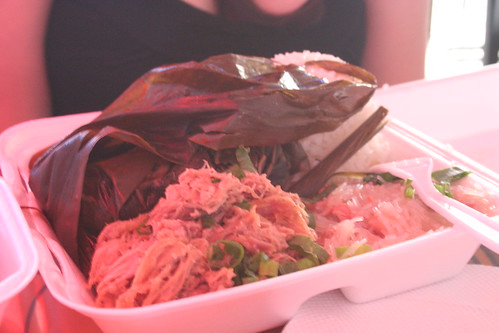 Surprisingly, the most satisfying kalua goes to Kula Sandalwoods Inn & Cafe. It's possible I was desperate for some good pig after the disappointment of Aloha Mix Plate, but this quaint, mellow place in the sleepy town of Kula really hit the spot. I felt a little bad that the place was so empty because it was simple and spot on. The kalua sandwich I had hit all the points on my kalua flavor checklist, plus the clever addition of hoisin sauce to "butter" the bread. Camille's grilled ono sandwich was similarly simple but with the little touch of goodness that is chopped tomatoes. The place is only open for breakfast and lunch, but if you're in Kula (and you should be), you'll be served by the family that owns the place and have a wonderful view of west Maui below you.
Surprisingly, the most satisfying kalua goes to Kula Sandalwoods Inn & Cafe. It's possible I was desperate for some good pig after the disappointment of Aloha Mix Plate, but this quaint, mellow place in the sleepy town of Kula really hit the spot. I felt a little bad that the place was so empty because it was simple and spot on. The kalua sandwich I had hit all the points on my kalua flavor checklist, plus the clever addition of hoisin sauce to "butter" the bread. Camille's grilled ono sandwich was similarly simple but with the little touch of goodness that is chopped tomatoes. The place is only open for breakfast and lunch, but if you're in Kula (and you should be), you'll be served by the family that owns the place and have a wonderful view of west Maui below you.
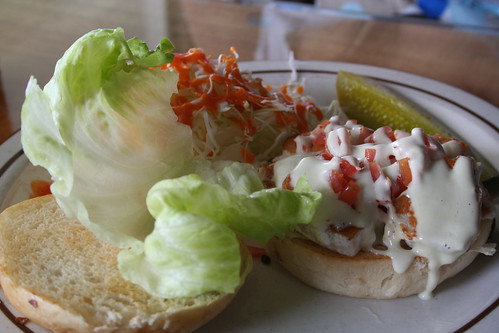 Some plate places will offer a loco moco all day. You certainly can't go wrong at any time with a loco moco, but it's supposed to be a breakfast dish, and we had a very good one at another Kula stop, Cafe 808.
Some plate places will offer a loco moco all day. You certainly can't go wrong at any time with a loco moco, but it's supposed to be a breakfast dish, and we had a very good one at another Kula stop, Cafe 808.
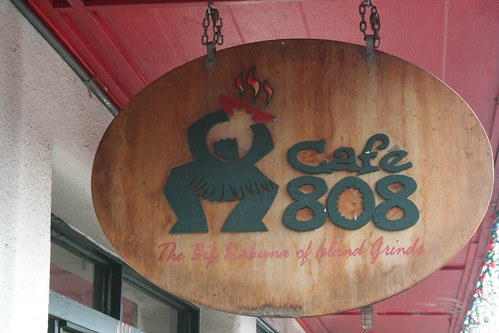 What kind of place is Cafe 808? From what I could tell, it's very no nonsense and caters mostly to locals. They don't even have a website. I mean: THEY DON'T HAVE A WEBSITE!!! If that's not antiquated and cute, I don't know what is. They also use fold up tables, feature some very old wood paneling, and generally have the look of an old community center/gym hybrid. In other words: a hole in the wall. I loved it.
What kind of place is Cafe 808? From what I could tell, it's very no nonsense and caters mostly to locals. They don't even have a website. I mean: THEY DON'T HAVE A WEBSITE!!! If that's not antiquated and cute, I don't know what is. They also use fold up tables, feature some very old wood paneling, and generally have the look of an old community center/gym hybrid. In other words: a hole in the wall. I loved it.
Kidding aside, they make a mean loco moco. Camille and I usually try not to order the same thing for the sake of adventure, but getting up at 3:30 am and racing the sun up to the top of Haleakala in a rented Corolla is adventure enough for us. We wanted filling, we wanted comfort, and we wanted it with a scoop of rice. Enter the loco moco, Hawaii's wonderful entry into the comfort food lexicon. A juicy beef patty topped by a fried egg (cooked to order, I like it runny), and the whole thing bathed in gravy. Those looking for a hearty breakfast can't ask for much more. If I lived in Kula, I'd probably eat here twice day, every day.
 Probably the best bang for your buck as far as plate lunches would go to Honokowai Okazuya & Deli. It's a tiny carry-out place in a strip mall with a Pizza Hut and a AAAAA Rent-A-Space, so it doesn't inspire much to look at it from the street. But the food is on par with most sit down restaurants, and if given the right location and ambience (like, say, the oceanfront locale of that tourist whore, Aloha Mix Plate), the owners could easily charge more. Instead, they pile the stuff into styrofoam boxes with plastic utensils and pass the savings onto you.
Probably the best bang for your buck as far as plate lunches would go to Honokowai Okazuya & Deli. It's a tiny carry-out place in a strip mall with a Pizza Hut and a AAAAA Rent-A-Space, so it doesn't inspire much to look at it from the street. But the food is on par with most sit down restaurants, and if given the right location and ambience (like, say, the oceanfront locale of that tourist whore, Aloha Mix Plate), the owners could easily charge more. Instead, they pile the stuff into styrofoam boxes with plastic utensils and pass the savings onto you.
 I went with the fish 'n' chips. The fish is panko-crusted, which is a delicious change of pace, making it light and crunchy. The real winner, though, is Camille's plate lunch of grilled fish in a lemon, butter, garlic, and white wine sauce. As Camille noted, it easily could have been a $20 dish at an entry-level fine dining establishment if it's served on a plate with real flatware. It's downright sinful as carry-out, rich and savory without being overbearing with the flavors. It wasn't just a pan full of butter -- which is delicious in its own right -- but a balanced combination between the wine, garlic, butter, and lemon. It was damn good.
I went with the fish 'n' chips. The fish is panko-crusted, which is a delicious change of pace, making it light and crunchy. The real winner, though, is Camille's plate lunch of grilled fish in a lemon, butter, garlic, and white wine sauce. As Camille noted, it easily could have been a $20 dish at an entry-level fine dining establishment if it's served on a plate with real flatware. It's downright sinful as carry-out, rich and savory without being overbearing with the flavors. It wasn't just a pan full of butter -- which is delicious in its own right -- but a balanced combination between the wine, garlic, butter, and lemon. It was damn good.
 Sorry, Aloha Mixed Plate, if that "tourist whore" comment seems harsh, but by comparison, you ain't nothing. You are dead to me. Up with Da Kitchen and Okazuya!
Sorry, Aloha Mixed Plate, if that "tourist whore" comment seems harsh, but by comparison, you ain't nothing. You are dead to me. Up with Da Kitchen and Okazuya!
Click here to read Part 2: Going Native.
Aloha Mixed Plate
1285 Front Street
Lahaina, HI 96761
(808)661-3322
www.alohamixedplate.com
Old Lahaina Luau (reservations required)
1287 Front Street
Lahaina, HI 96761
(800)248-5828
www.oldlahainaluau.com
Da Kitchen
Rainbow Mall
2439 South Kihei Road #A107
Kihei, HI 96753
(808)875-7782
Triangle Square
425 Koloa Street #104
Kahului, HI 96732
(808)871-7782
www.da-kitchen.com
Kula Sandalwoods Inn & Cafe
15427 Haleakala Highway
Kula, HI 96790
(808)878-3523
www.kulasandalwoods.com
Cafe 808
4566 Lower Kula Road
Kula, HI 96790
(808)878-6874
Honokowai Okazuya & Deli
3600 Lower Honoapiilani Road #D
Lahaina, HI 96761
(808)665-0512
www.mauihawaii.org/restaurants/okazuya.htm

